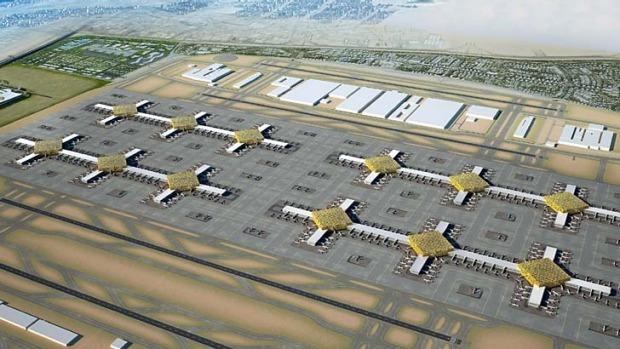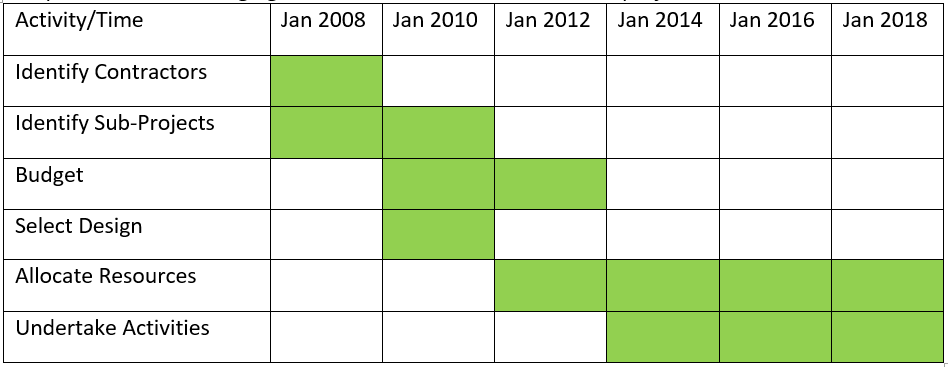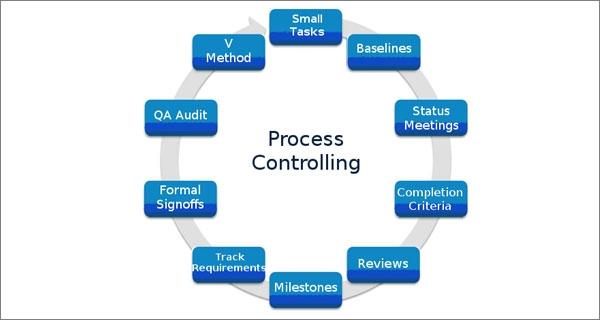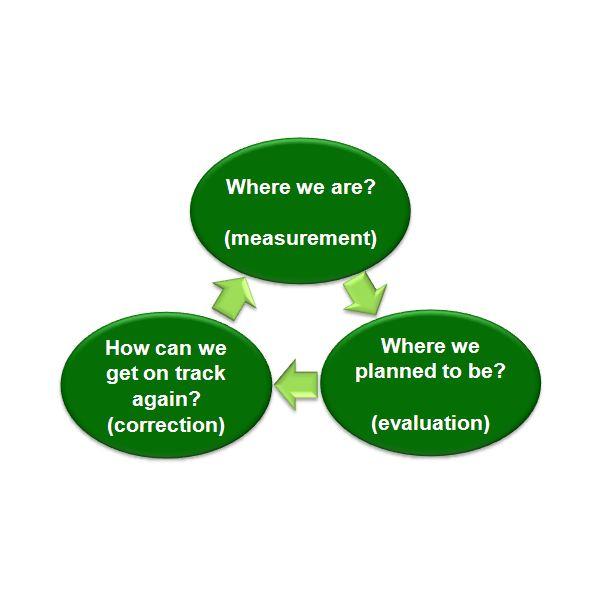Company Profile
Al Maktoum International Airport is an international airport located in Jabel Ali, approximately 23 miles southwest of Dubai (Turner, 2017). The airport plays a critical role in ensuring that there is the ease of movement of passengers and cargo from Dubai to the rest of the world and vice versa. Constructed using state-of-the-art technology, the airport is meant to meet the rising demand for passenger and cargo planes regularly landing and taking off within the city of Dubai.
The airport is wholly owned and managed by the government of Dubai. Although the airport is still undergoing further improvements as per its original plan, it has already begun its operations. Cargo planes have been using the airport since June 2010. In February 2011, the airport received its certification to start handling passenger airlines. Since then, major improvements have been made at the airport to make it become one of the largest and best-equipped airports in the world. In this paper, the focus will be on the Al Maktoum International Airport Cargo Gateway project, which is one of the many projects initiated to transform the airport to modern-day standards.
Importance of Project Management
The project to expand Al Maktoum International Airport was very important in transforming it from a small port that handles domestic flights to a major international airport that is capable of handling over 260 million passengers and 12 million tons of cargo every year. According to Young (2013), it is critical to define the importance of a project to help justify the need to invest in it. Project management is important because it defines the activities that should be undertaken, the time available for each activity, individuals responsible, and the resources needed to complete them as per the plan.
In the project designed to expand this airport, the goal of the owners of the project (the government of Dubai) was to ensure that this airport is transformed to become a leading international airport that meets the modern standards to help in easing the pressure on the other international airports within the city. The strategic location of the airport also shows that one of the major concerns of the project owners was to promote international trade and to position the city of Dubai as a reliable global business hub where the movement of goods and people is made ease.
Project Planning
According to Kemp (2012), before undertaking any project, it is important to come up with a plan that identifies activities that should be carried out, timing, resources, and individuals that will be involved at various stages of the project. It involves the setting of goals, the definition of the project, and the organization of the team. The following were the goals set by the government when initiating the project:
- To increase the capacity of Al Maktoum International Airport to handle 12 million tons of cargo and 260 million passengers;
- To have a start-of-the-art airport facility that meets the needs of the modern-day travelers;
- To promote Dubai as a global business hub by making it easy for cargo and passengers to move into and out of the city with ease.
The government identified several contractors who were awarded different tasks within the project based on their qualifications. One of the construction companies that were awarded a tender to help in the expansion of the airport was The Lane Construction Corporation, which is an American company. The following figure 1 shows the architectural plan of the airport.

Project Cost
The initial budget for the project that was set out before the 2008/2009 global economic recession was affected by the global recession, and it had to be adjusted upwards to meet the rising cost of materials and labor. The cargo gateway project was assigned USD 125 million and was awarded to two different companies. The first construction company that was assigned 60% of the project’s activities had to work with a budget of USD 75 million. The second construction company worked with a budget of USD 50 million.
The Project Manager
The mega project of transforming the Al Maktoum International Airport was divided into specific tasks and then assigned to different contractors based on their approved qualifications. Although the operations of the entire project were under the watchful eye of the government through the Dubai Airports, each contractor worked semi-autonomously, only engaging other contractors in cases where it was necessary to share knowledge and ideas on how to deliver superior value to the customer (Dubai Airports Company). HH Sheikh Ahmed Bin Saeed Al Maktoum is the chairperson of the Dubai Airports, the company that owns Al Maktoum International Airport.
However, Paul Griffiths has been acting as a project manager, overseeing activities of various contractors, and ensuring that they deliver the value they promised. In each project assigned to a given contractor, the chief engineer assigned to the project by the contractor acts as the project manager. However, the desire to have consistency and uniformity has made it necessary for the chief executive officer of Dubai Airports to step in and enhance coordination of activities to ensure that the end of the project achieves the targeted goals.
Ethical Considerations
It is the responsibility of the project manager (PM) to ensure that ethical issues are taken into consideration throughout the project. The PM should ensure that the entire team works as per the expectations of the employer and other stakeholders.
Work Breakdown Structure
The project involved a series of activities that were assigned to different entities to ensure that the project is completed in time and as per the expectations of the government. The work breakdown structure helps in identifying individual activities that were undertaken when carrying out the project. The structure is always critical in knowing who to assign which task-based on expertise and how different teams will work in a coordinated manner to enhance uniformity in the project. According to Snyder (2013), having an effective work breakdown structure makes it possible to lay out how different individuals or entities will complete the entire project. In this project, the following work breakdown structure was relevant.

Project Scheduling
One of the most important areas when undertaking a project is the process of scheduling the activities. After identifying the activities that should be carried out, the next important face is to schedule the activities in a way that would yield the expected outcome in the best way possible. Project scheduling must be done correctly, taking into account the degree of the complexity of each activity and the fact that some activities can only be undertaken if other activities have been completed. A critical path can be useful in understanding how to schedule various activities within the project.
Critical Path
Using a critical path, the project manager and the financiers of the project will understand how each of the activities will be done sequentially and the reasonable date within which the project is likely to be completed. The following figure shows the critical path that defines how the activities will be carried out in this project.

The above figure provides a detailed summary of the activities to be carried out and the time that they are expected to be completed in line with the set deadlines.
Forward and backward pass
It is possible to find cases where the project manager or owner is interested in determining the absolute time that the project will undertake. In such instances, it is important to determine the early start (ES) and early finish (EF) using the forward pass technique (Kogon, Blakemore, & Wood, 2015). The backward pass technique is also useful in determining the late start and late finish. With this information, it is possible to inform the employer about the time that the project is likely to be completed.
Gantt chart
A Gantt chart is a visual tool that outlines the activities to be undertaken and the time they are expected to be completed. Using a Gantt chart, it is possible to outline the employer activities that should be carried out and the time within which they should be completed. The following figure 4 shows the Gantt chart for the project.

Project Controlling
According to Snyder (2013), project control involves observation of project executions to identify potential threats or weaknesses on time so that corrective measures can be taken to avoid any negative consequences. It involves gathering data, management, and analysis of the data and making necessary predictions concerning the time and cost outcomes of a project to help in making the right decision. The expansion of Al Maktoum International Airport is a megaproject that requires a proper project controlling mechanism. The figure below shows how that can be done.

As shown in the above figure, the entire process is cyclic in nature, starting with the identification of the small tasks within the project to the last stage of evaluating the method. It means that the process should remain continuous as long as the project is still in progress, until such a time that it is officially handed over to the owner.
Project Management Techniques
According to Kemp (2012), project management refers to a process of initiation, planning, execution, controlling, and closure of all activities involved in a project as per the client’s expectations based on specified success criteria. It involves conducting measurements to determine the current position, evaluating the desired position, and defining a path that can be used to reach the desired destination, as outlined in the figure below.

Project management should start with the identification of specific milestones that should be achieved in the projects. The Al Maktoum International Airport project has all the activities lined out. PERT and CPM framework can be useful in project management.
PERT Framework as a Tool for Project Management
Using the PERT framework, it is possible to determine how long the entire project is likely to take, especially when handling a sensitive project such as the expansion of the Al Maktoum International Airport. The framework identifies six essential steps, which must be taken into consideration. The first step is to define the project and all the relevant activities involved (Young, 2013). In the case of this project, the activities are outlined in the figure above. The next step is to determine the relationship between the activities, as done in the figure above. A network should then be drawn that connects the activities. Time and cost should be estimated and then assigned to the activities before computing the longest path in the network (Snyder, 2013). The following figure shows the PERT Matrix that can help in evaluating reviewing the project activities.

Probability of Project Completion
To compute a probability of project completion, the following formula will be useful:
Project standard deviation= √Project Variance
Table 1. Project variance (Developed by the author).
Project standard deviation= √6.83 = 2.61
Network Diagrams and Approaches
It is important to understand the importance of the network diagrams and approaches when undertaking a mega project such as that of Al Maktoum International Airport. The diagrams help in identifying the pattern of activities within the project and how each activity is related to others. Snyder (2013) says that this is often done to avoid confusion and delays where one activity that must be completed before proceeding to another is not done on time, forcing other activities to come to a temporary halt. The project manager, using the network diagrams, can plan project members in a manner that will ensure that all activities are undertaken in a systematic.
Activity-on-Node
According to Kemp (2012), activity-on-node is a precedence diagramming approach where boxes are used in denoting the schedule of activities. The activities are related in a way, from start to finish. As shown in figure 3 above, some activities must be completed first before other activities can be undertaken. For instance, the management of Al Maktoum International Airport must first identify and then select appropriate contractors before the sub-projects in the entire project are identified. To ensure that individual activities in the project are undertaken, the company must allocate resources to facilitate the activities. With that knowledge, the project manager knows what to give priority at every stage of the project.
Activity-on-Arrow
Activity on the arrow is often used to specify the duration that each activity should take in a critical path diagram. The arrow between the nodes indicates the time that it will take to complete one activity so that the next activity should be undertaken. For instance, the time needed by the management to identify and select contractors must be stated as shown in the Gantt chart to help the project manager to plan project activities.
References
Kemp, G. (2012). The East moves West: India, China, and Asia’s growing presence in the Middle East. Washington, DC: Brookings Institution Press.
Kogon, K., Blakemore, S., & Wood, J. (2015). Project management for the unofficial project manager: A Franklin Covey title. Dallas, TX: BenBella Books, Inc.
Snyder, C. (2013). A project manager’s book of forms: A companion to the PMBOK guide, fifth edition. Hoboken, N.J: Wiley.
Turner, T. (2017). Dubai travel guide 2017: Must-see attractions, wonderful hotels, excellent restaurants, valuable tips and so much more. Hoboken, NJ: Wiley.
Young, T. L. (2013). Successful project management. Philadelphia, PA: Kogan Page Limited.